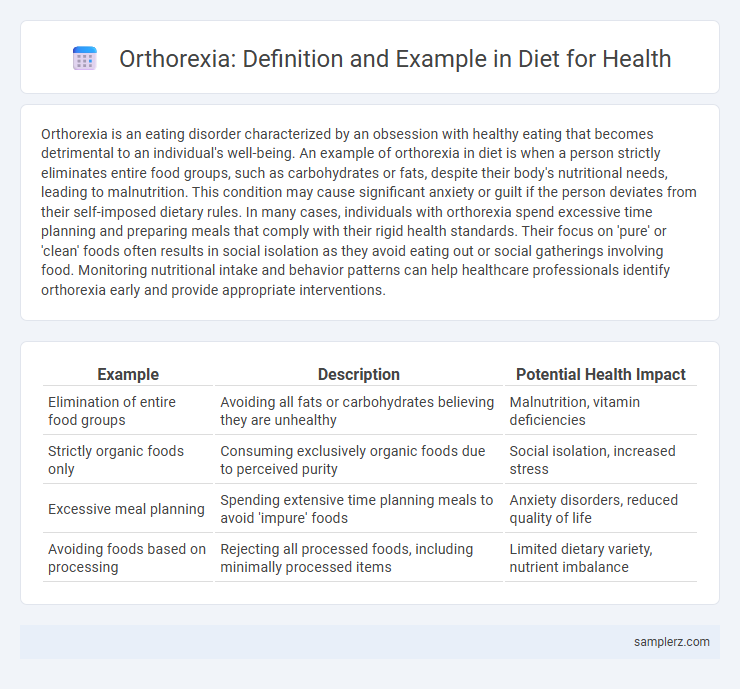Orthorexia is an eating disorder characterized by an obsession with healthy eating that becomes detrimental to an individual's well-being. An example of orthorexia in diet is when a person strictly eliminates entire food groups, such as carbohydrates or fats, despite their body's nutritional needs, leading to malnutrition. This condition may cause significant anxiety or guilt if the person deviates from their self-imposed dietary rules. In many cases, individuals with orthorexia spend excessive time planning and preparing meals that comply with their rigid health standards. Their focus on 'pure' or 'clean' foods often results in social isolation as they avoid eating out or social gatherings involving food. Monitoring nutritional intake and behavior patterns can help healthcare professionals identify orthorexia early and provide appropriate interventions.
Table of Comparison
| Example | Description | Potential Health Impact |
|---|---|---|
| Elimination of entire food groups | Avoiding all fats or carbohydrates believing they are unhealthy | Malnutrition, vitamin deficiencies |
| Strictly organic foods only | Consuming exclusively organic foods due to perceived purity | Social isolation, increased stress |
| Excessive meal planning | Spending extensive time planning meals to avoid 'impure' foods | Anxiety disorders, reduced quality of life |
| Avoiding foods based on processing | Rejecting all processed foods, including minimally processed items | Limited dietary variety, nutrient imbalance |
Understanding Orthorexia: Health Obsession Gone Too Far
Orthorexia is characterized by an obsession with eating only "pure" or "clean" foods, leading to restrictive diets that may cause nutritional deficiencies and social isolation. Individuals might eliminate entire food groups, such as fats or carbohydrates, believing these are harmful regardless of their nutritional benefits. This extreme focus on food quality over quantity can disrupt daily functioning and overall well-being, highlighting the importance of balanced eating habits.
Common Orthorexic Eating Patterns
Common orthorexic eating patterns involve an excessive focus on food purity and quality, often resulting in the elimination of entire food groups such as gluten, dairy, and processed sugars. Individuals with orthorexia may adhere to strict rules about organic, non-GMO, and raw foods, prioritizing perceived health benefits over nutritional balance. This obsession with "clean eating" can lead to nutritional deficiencies, social isolation, and significant distress related to food choices.
Signs of Orthorexia in Everyday Diet
Persistent obsession with consuming only "pure" or "clean" foods, such as exclusively raw or organic products, signals orthorexia in everyday diet patterns. Avoidance of foods perceived as unhealthy, including processed snacks or those containing additives, often causes nutritional imbalances and social isolation. Excessive time spent planning, researching, and preparing meals based on strict purity criteria highlights the compulsive nature of orthorexia nervosa.
“Clean Eating” and Orthorexia: Where’s the Line?
Clean eating, which emphasizes consuming whole, unprocessed foods, can sometimes lead to orthorexia when the focus on purity becomes an obsession, causing anxiety and social isolation. Orthorexia nervosa is characterized by an unhealthy fixation on eating "clean" foods that interferes with daily functioning and nutritional balance. Recognizing the line between healthy eating and orthorexia involves monitoring restrictive behaviors, malnutrition signs, and the psychological distress linked to rigid dietary rules.
Social Media Trends Fueling Orthorexic Behaviors
Social media trends promoting "clean eating" and restrictive diets often glorify extreme focus on food purity, contributing to orthorexic behaviors. Influencers frequently share meticulously curated meals and strict health routines, which can pressure followers to adopt unhealthy obsessions with food quality. This digital environment intensifies anxiety over food choices, leading to rigid eating habits and social isolation in individuals vulnerable to orthorexia.
Real-Life Diet Examples of Orthorexia
A common example of orthorexia involves individuals strictly avoiding foods perceived as unhealthy, such as eliminating all processed foods, sugars, and fats from their diet, which can lead to nutritional imbalances. Real-life cases often include people obsessively consuming only organic, raw, or plant-based foods and spending excessive time planning meals to maintain perceived purity. This rigid focus on food quality rather than quantity can cause social isolation and anxiety around eating situations.
Restrictive Meal Plans and Nutrient Deficiencies
Orthorexia manifests in restrictive meal plans characterized by the exclusion of entire food groups such as carbohydrates, fats, or dairy, leading to imbalanced nutrient intake. Individuals often eliminate nutrient-dense options like whole grains and legumes, resulting in deficiencies in essential vitamins and minerals including B vitamins, iron, and calcium. Prolonged adherence to these diets may cause fatigue, weakened immunity, and impaired cognitive function due to insufficient macronutrient and micronutrient consumption.
The Psychological Impact of an Orthorexic Diet
Obsessing over a perfectly clean diet can lead to orthorexia, an eating disorder characterized by an unhealthy fixation on food quality and purity. This obsession often results in severe anxiety, social isolation, and decreased mental well-being as individuals rigidly adhere to self-imposed dietary rules. Psychological impacts include increased stress levels, compulsive behaviors, and a distorted relationship with food that can interfere with daily functioning and overall health.
How Orthorexia Differs from Healthy Eating
Orthorexia is characterized by an obsessive focus on eating only foods perceived as healthy, leading to restrictive diets that cause nutritional deficiencies or social isolation. Unlike balanced healthy eating, orthorexia involves anxiety about food purity and an inflexible approach to diet rules. This contrasts with flexible eating habits that prioritize overall well-being and accommodate occasional indulgences.
Overcoming Orthorexia: Steps Toward Balanced Nutrition
Overcoming orthorexia involves gradually reintroducing a variety of foods to reduce rigid food rules and anxiety around eating. Working with a registered dietitian specializing in eating disorders can help establish flexible meal plans that promote mental and physical health. Mindfulness practices and cognitive-behavioral therapy have proven effective in addressing obsessive behaviors and fostering a healthier relationship with food.

example of orthorexia in diet Infographic
 samplerz.com
samplerz.com